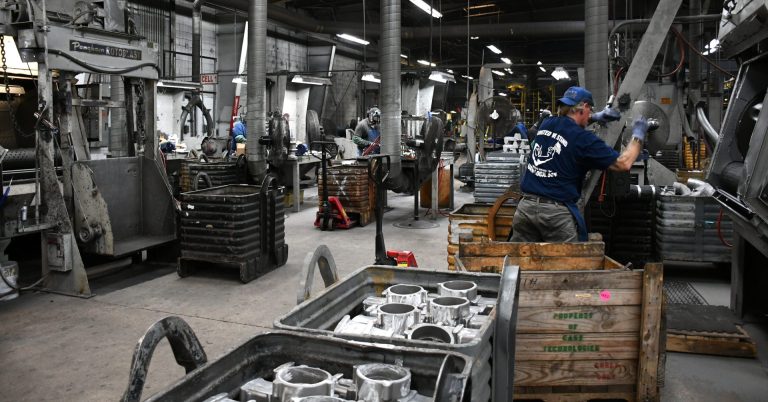Opening Excellence: Aluminum Casting Techniques & Tips for Superior Outcomes
Opening Excellence: Aluminum Casting Techniques & Tips for Superior Outcomes
Blog Article
Dive Into the World of Light Weight Aluminum Spreading: Comprehending the Different Approaches
Light weight aluminum casting is an essential procedure in the manufacturing sector, with numerous approaches used to develop complex and specific elements. From the conventional sand casting approach to the advanced die spreading procedure, each approach offers distinct advantages depending on the requirements of the job.
Sand Spreading Method
Sand casting, a widely-used approach in light weight aluminum spreading procedures, includes creating molds made of compressed sand for pouring liquified metal. Once the mold and mildew is prepared, it is securely placed in a flask and molten light weight aluminum is put into the cavity.
After the steel has actually cooled down and strengthened, the sand mold is escaped to reveal the light weight aluminum spreading. Sand casting allows for the production of complicated forms and huge components that might be costly or difficult to create making use of various other approaches. It is additionally a lasting technique as the sand can be reused and used multiple times, reducing waste in the casting process.
Permanent Mold Method

One significant benefit of the Irreversible Mold And Mildew Method is the enhanced dimensional accuracy it supplies. The metal mold and mildew enables tighter tolerances and better details in the final aluminum spreadings contrasted to sand casting methods. This precision makes it a recommended option for applications where tight dimensional control is essential, such as in the vehicle and aerospace industries.

Die Casting Process

Financial Investment Casting Method
Using an accuracy casting technique, Financial investment Casting Method involves creating complex aluminum parts by pouring molten steel right into a ceramic mold. This process, likewise recognized as lost-wax casting, starts with the development of a wax pattern of the preferred component (aluminum casting).
Financial investment spreading is typically made use of for making parts in sectors where limited resistances and complex styles are needed, such as aerospace, automobile, and clinical devices. The adaptability and precision of the Financial investment Casting Method make it a beneficial technique in the world of light weight aluminum casting.
Lost Foam Spreading Approach
Having actually discovered the elaborate accuracy of Financial look at here now investment Casting Approach, the focus now changes to the innovative technique of Lost Foam Casting in light weight aluminum element manufacturing. Lost Foam Casting, likewise referred to as evaporative pattern casting, is a contemporary method where a foam pattern of the desired component is produced and then covered with a refractory product. The covered foam pattern is after that buried in sand, and molten aluminum is poured right into the mold and mildew. As the steel loads the mold, the foam evaporates as a result of the warmth, leaving a clean cavity in the form of the preferred part.
Among the major benefits of Lost Foam Spreading is its capability to create intricate shapes with complex details, typically in a solitary item without the need for added machining. This approach is additionally understood for its high dimensional precision and smooth surface finish. Additionally, Lost Foam Casting is a cost-efficient procedure as it minimizes the demand for cores and allows for the production of light-weight parts. Regardless of its advantages, Lost Foam Casting calls for careful control of the spreading procedure to stop issues and ensure quality elements.
Conclusion
To conclude, light weight aluminum casting supplies a selection of techniques such as sand casting, long-term mold and mildew technique, die spreading, financial investment casting, and lost foam spreading. Each approach has its very own advantages and applications, making light weight aluminum casting a versatile and widely utilized process in various sectors. Comprehending the differences between these techniques is critical in choosing you can try here the most appropriate casting technique for certain manufacturing demands.
Sand casting, a widely-used approach in aluminum casting procedures, entails producing molds made of compressed sand for pouring liquified steel. aluminum casting.The Permanent Mold Strategy, like sand casting, is another widespread technique utilized in aluminum spreading procedures, providing distinct advantages in terms of mold reusability and dimensional precision. The steel mold and mildew allows for tighter tolerances and finer information in the final light weight aluminum spreadings contrasted to sand spreading methods. The 2 major types of die spreading are chilly chamber pass away spreading and warm chamber pass away casting, each appropriate for various types of light weight aluminum alloys.In final thought, aluminum casting uses a variety of methods such as sand casting, permanent mold and mildew method, pass away casting, financial investment spreading, and shed foam spreading
Report this page